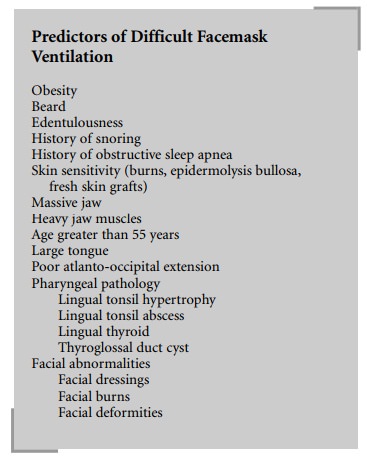Chapter: Clinical Cases in Anesthesia : The Difficult Airway
What are the predictors of difficult mask ventilation?
What are the predictors of difficult mask ventilation?
One of the most important predictors of the
difficult air-way is a history of difficult airway. The opposite is not
neces-sarily true. A history of problem-free airway management is suggestive of
future ease, but not a guarantee. Many factors that contribute to difficulty
are progressive. Examples of such problems include rheumatoid arthritis and
obesity. An airway history should be elicited from all patients. Review of
prior anesthesia records is frequently helpful. They may describe previously
encountered problems, failed therapies, and successful solutions.
Difficult facemask ventilation occurs when a
practi-tioner cannot provide sufficient gas exchange due to inad-equate mask
seal, large volume leaks, or excessive resistance to the ingress or egress of
gas. This occurs with an incidence of 0.08–5%. The wide range is probably due
to conflicting definitions of difficult mask airway. Risk factors for difficult
mask ventilation include full beard, massive jaw, edentulousness, skin
sensitivity (burns, epidermolysis bullosa, fresh skin grafts), facial
dressings, obesity, age greater than 55 years, and a history of snoring. Other
criteria that suggest the possibility of difficult facemask ventilation include
large tongue, heavy jaw muscles, history of obstructive sleep apnea, poor
atlanto-occipital extension, some types of pharyngeal pathology, facial burns,
and facial deformities. Multiple types of pharyngeal problems can produce
difficult facemask ventilation. They include lingual tonsil hypertrophy,
lingual tonsillar abscess, lingual thyroid, and thyroglossal duct cyst. Many of
these cannot be diagnosed by classical airway examination techniques. The
presence of any one factor is suggestive of difficult mask ventilation. The
more factors present at the same time, the greater the likelihood of
difficulty. Increased mandibulo-hyoid distance has been associated with
obstructive sleep apnea, the pathophysiology of which may be related to
difficult mask ventilation.

Traditional facemask airway management is
generally safe and effective. In the unusual instances when it is not, tracheal
intubation remains the fallback option. Although this scheme works well in most
cases, approximately 15% of difficult intubations are also difficult mask
airways.
Related Topics